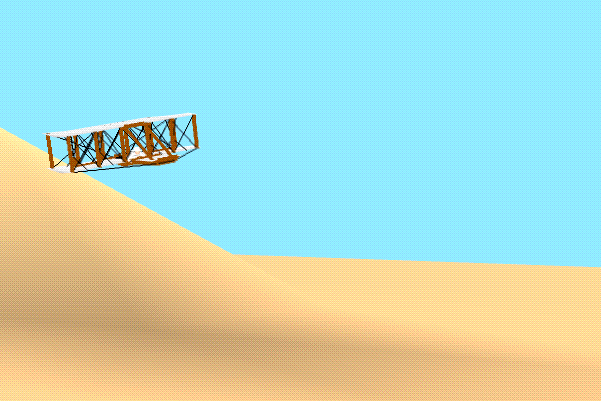Wing Warping Interactive
One of the major breakthroughs of the Wright brothers was the ability to control and maneuver their aircraft. Roll control was provided by a unique idea called wing warping. The tips of their wings could by twisted relative to the rest of the wing by a series of cables.
Mechanics
The mechanics of wing warping is shown with the aircraft fixed in space. The central cells of the wing are held in place by wire rigging so that the vertical struts can not move relative to the wings. But the outer cell of each wing is wired differently. There are no cross wires on the outer struts except at the front. The leading edge of each wing is kept straight by the rigging wires, but the rear portion of each wing can move relative to the rest of the wing. There are additional control wires at the rear of the wing which connect the wing tips to a pedal at the foot of the pilot. As the pilot pushes the pedal, the wire pulls on the wing tip and the shape of the outer panel changes. (Push the “Mechanics” button and move the slider to see the change in shape)
Lift Force
Changing the angle of deflection at the rear of an airfoil will change the amount of lift generated by the foil. With greater downward deflection, the lift will increase in the upward direction. If you select the “Lift Force” button you will see the distribution of lift across the wing. We represent the lift by a series of red arrows whose length is proportional to the lift in that section of the wing. If the tip of the right wing, as viewed from the front of the aircraft, is deflected down, the tip of the left wing is deflected slightly upward. Therefore, the lift on the right wing is increased, while the lift on the left wing is decreased. We display these forces and the wing deflection with the aircraft fixed in space. In response to the unequal forces on each wing, the aircraft will rotate about its center of gravity and change its attitude as it moves through the air.
Attitude
Because of unequal forces on the wings of the aircraft, the aircraft will roll or bank in the direction of the smaller force. (The wing with the higher lift will move upward, the wing with the lower lift will move downward.) You can investigate this behavior with the Java program by pushing the “Attitude” button and then move the slider. The orientation of the aircraft as a result of the varying lift forces is displayed in the graphics.
Forces
When the aircraft banks or rolls to one side, the balance of forces on the aircraft is changed and the aircraft moves in a new direction. The weight force is always directed towards the center of the earth. In a wings-level cruise condition, the lift is perpendicular to the flight direction and opposes the weight. The lift acts nearly perpendicular to the wing surface. When the aircraft (and the wing) rolls to one side, the lift remains perpendicular to the flight path and the wing surface. A large portion of the lift still opposes the weight, but there is now a component of the lift which produces a side force on the aircraft. You can investigate this side force by pushing the “Forces” button on the program and moving the slider.
Resulting Motion
The side force is unopposed by any other force and so the aircraft moves in that direction in accordance with Newton’s first law of motion. The side force is a centralized force; it is always perpendicular to the flight path because it is a component of the lift. An object subjected to a centralized force moves in a circular path. This animation shows the motion of the 1901 aircraft when the right wing tip as viewed from the pilot is deflected down.

If the aircraft is rolled in the opposite direction, the plane turns in the opposite direction. Notice that banking an aircraft to one side causes the aircraft to turn in that direction. The turning is not the result of a rudder input as it would be on a boat. The 1901 aircraft had no rudder. Airplanes are turned by banking or rolling. The rudder on an airplane is just used to keep the nose pointed in the correct direction in order to eliminate a condition called adverse yaw and to bring the thrust vector into the turn on high performance aircraft.
The Wright brothers used wing warping for roll control on their 1901 and 1902 gliders and on the successful 1903 flyer. Modern airliners and fighter planes, however, no longer use wing warping for roll control. They typically use either ailerons or spoilers which are moving sections on the wing of the aircraft. When you travel on an airliner, watch the wings during turns. The pilot rolls the aircraft in the direction of the turn. You will probably be surprised at how little deflection is necessary to bank (roll) a large airliner. You can tell whether an airliner is using spoilers or ailerons by noticing where the moving part is located. At the trailing edge, it’s an aileron; between the leading and trailing edges, it’s a spoiler.
